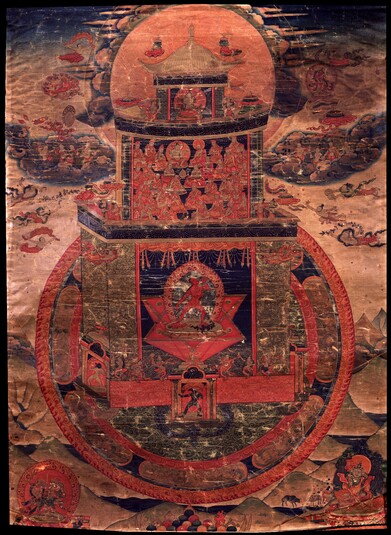
Item: Vajrayogini (Buddhist Deity) - (Naropa Tradition)
| Origin Location | Tibet |
|---|---|
| Date Range | 1800 - 1899 |
| Lineages | Sakya |
| Size | 44.12x32.05cm (17.37x12.62in) |
| Material | Ground Mineral Pigment on Cotton |
| Collection | The Brooklyn Museum of Art |
| Catalogue # | acc. #BMA 75.57, Gift of Dr. and Mrs. Lewis Fraad |
Classification: Deity
Appearance: Semi-Peaceful
Gender: Female
Vajrayogini and the Pure Land of Khechara (Tibetan: dor je nal jor ma, kha cho), from the tradition of mahasiddha Naropa. A deity of the Anuttarayoga wisdom class arising out of the Chakrasamvara cycle of Tantras.
Sanskrit: Vajrayogini Tibetan: Dor je nal jor ma
Tibetan: Dor je nal jor ma
The dakini Vajrayogini, of the Naro Khechari lineage, is the small central red figure with one face and two hands surrounded by a ring of flame standing on a double tetrahedron within a three-storied heavenly palace. Resting on a large circular mandala within the larger Buddha realm of Akanishta, this is the pure buddha-realm of Vajrayogini. Below are six offering goddesses and two animal-headed protector deities as door guardians. On the upper floor are the Sakya teachers of the Vajrayogini lineage. In the top story is Buddha Vajradharma holding a vajra and bell crossed at the heart, seated.
At the bottom left are the two skeletons Shri Chitipati and in the right corner, the Guardian of the Northern Direction, Vaishravana.
Vajrayogini is a representation of complete buddhahood in female form. Classified as Wisdom or 'Mother' Anuttarayoga Tantra the practices originate with the Chakrasamvara Cycle of Tantras. Although found in a variety of forms the practice is common to all schools of Tibetan Buddhism. In this form she represents a special teaching passed down from the lineage of the Indian mahasiddha Naropa through to the Sakya School and later found popularity within the Gelugpa Tradition.
Guru Lineage: Vajradhara, Vajrayogini, mahasiddha Naropa, Phamthingpa, Sherab Tseg, Mal Lotsawa, Sachen Kunga Nyingpo, Sonam Tsemo, Trakpa Gyaltsen, Sakya Pandita, Chogyal Pagpa, etc.
Jeff Watt 3-2002
Tradition: Sakya Deity Paintings
Buddhist Deity: Vajrayogini Main Page
Subject: Sacred Geography Main Page
Buddhist Deity: Deities (Female)
Buddhist Deity: Vajrayogini Mandalas
Buddhist Deity: Vajrayogini, Khechara (Naropa Tradition)
Collection of Brooklyn Museum of Art
Buddhist Deity: Vajrayogini, Khechara Pureland
Collection of Brooklyn Museum of Art (Deities)
